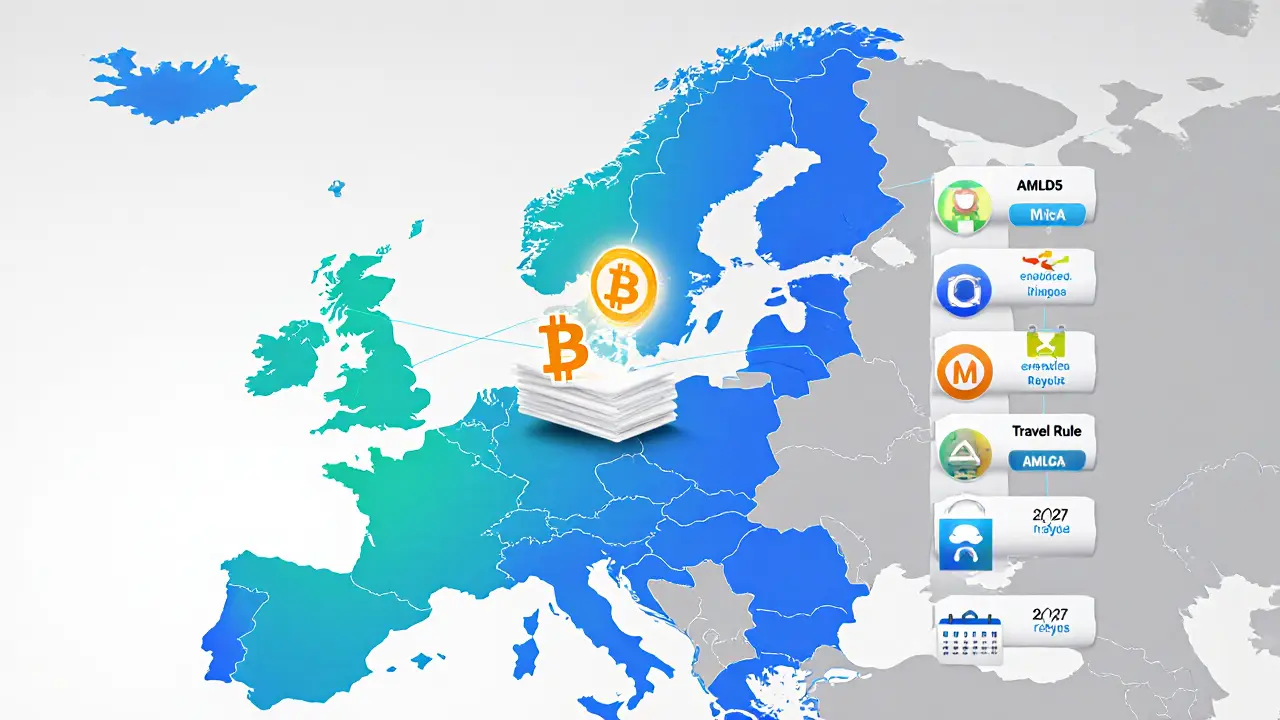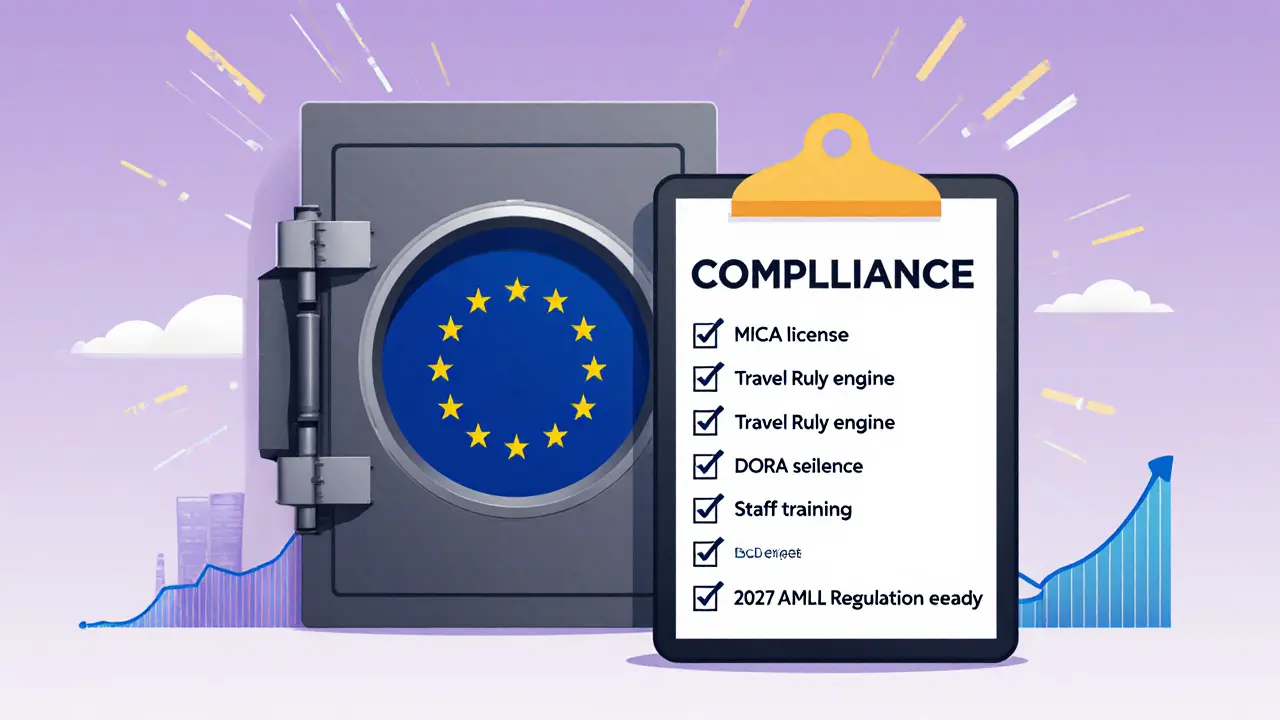EU AML Rules for Crypto Companies: What You Must Know
 Mar, 21 2025
Mar, 21 2025
EU Crypto AML Compliance Cost Calculator
Compliance Assessment
Compliance Cost Estimate
€0
Time to implement: 0 months
Key Considerations:
Based on your inputs, your main requirements are...
EU AML regulations for crypto businesses is a unified legal framework that forces digital‑asset firms to fight money‑laundering and terrorist‑financing risks across all 27 member states. It blends directives, regulations and authority‑level rules that started with AMLD5 in 2020 and will culminate in the EU‑wide AML Regulation in 2027. If you run an exchange, custodial wallet, DeFi platform or any service that moves crypto, you need a clear roadmap to stay compliant and avoid hefty fines.
How the EU got here: a quick timeline
Understanding where the rules come from helps you see why each piece matters.
- AMLD5 (Jan 2020) - first EU directive to pull fiat‑to‑crypto exchanges and custodial wallets into AML oversight.
- AMLD6 (2022) - added stricter penalties, a harmonized list of predicate offences and senior‑management liability.
- MiCA (full effect 2024) - introduced a licensing regime for Crypto‑Asset Service Providers (CASPs) and set market‑integrity standards.
- Travel Rule (Transfer of Funds Regulation, 2023) - obliges every crypto transfer to carry full sender/receiver data, no minimum threshold.
- DORA (Jan 2025) - requires robust ICT resilience against cyber‑attacks.
- AMLA (2025) - the new EU Anti‑Money‑Laundering Authority that coordinates supervision.
- EU‑wide AML Regulation (July 2027) - will replace the older directives with a single rulebook.
Core AML components you must implement
All of these sit on top of each other, so missing one can trigger a breach.
- Customer Due Diligence (CDD) - tiered verification:
- Basic: name + address for transactions < €1,000.
- Enhanced: ID document for €1,000‑€10,000.
- Strict Enhanced: source‑of‑funds check & senior‑approval for > €10,000.
- Appoint a dedicated Money Laundering Reporting Officer (MLRO) who signs off all Suspicious Transaction Reports (STRs).
- Maintain an internal AML policy, risk‑assessment report and annual training (40 h for compliance staff, 16 h for ops staff - per ESMA guidelines).
- Implement the Travel Rule data capture: originator name, account number, physical address or DOB; beneficiary name, account number, physical address.
- Integrate with 28 national Financial Intelligence Units (FIUs). Most firms use a middleware like Traveler to cut integration time from six months to eight weeks.
- Ensure ICT systems meet DORA resilience standards - regular penetration testing, backup redundancy and incident‑response plans.
Step‑by‑step compliance roadmap
Turn the abstract rules into concrete actions.
- Map your service type: exchange, custodial wallet, DeFi protocol, or hybrid. Identify which EU licences (MiCA, AMLD5/6) apply.
- Run a risk‑based assessment (use the AMLA 2025 work‑program template). Document high‑risk jurisdictions, transaction volumes and privacy‑enhancing tech used.
- Build a KYC/AML stack:
- Identity verification provider (e.g., Onfido, Veriff).
- Travel Rule engine - either in‑house or SaaS (Traveler, Chainalysis KYT).
- Transaction monitoring system tuned to crypto‑specific red flags (rapid volume spikes, mixed‑coin mixers, cross‑chain bridges).
- Hire or designate an MLRO. Draft internal procedures for STR filing, escalation and record‑keeping (minimum five‑year archive).
- Connect to each national FIU. Allocate €185,000 per connection - budget accordingly or negotiate bulk‑integration discounts.
- Train staff. Keep a log of completed hours and pass quarterly knowledge quizzes (required by ESMA).
- Run a pre‑audit with an external AML consultancy. Fix gaps before the AMLA supervisory review scheduled for Q2 2026.
Common challenges and practical tips
Even big players hit snags. Here’s what works.
- Cost pressure on SMEs - you can share a compliance platform with a partner or join a crypto‑industry compliance consortium that spreads licensing fees.
- DeFi supervision - treat the protocol’s governing DAO as the ‘legal entity’. Register a legal wrapper (e.g., a Dutch foundation) to satisfy AMLA’s “beneficial‑owner” rules.
- Data‑privacy concerns - perform impact assessments that balance GDPR with AML data‑collection. Document legitimate‑interest justifications for each data field.
- Cross‑border reporting speed - set internal SLA of five working days for FIU responses, matching the upcoming 2027 AML Regulation deadline.
Future outlook: the 2027 AML Regulation
What’s coming next, and how to prepare now.
The regulation will tighten due‑diligence deadlines, lower the cash‑payment ceiling to €10,000, and expand obliged entities to include crypto‑fundraisers, professional sports agents and high‑value‑goods traders. It also promises a Europe‑wide five‑day response window for FIU queries - meaning you should already have automated query‑handling in place.
Experts estimate another 40‑55 % drop in illicit crypto flows by 2028 if firms adopt the full suite now. That translates into a competitive edge: regulated CASPs currently capture 89 % of institutional crypto business in the EU.

Quick compliance checklist
| Item | What to Do | Typical Cost / Time |
|---|---|---|
| Licensing (MiCA) | Submit application to national competent authority | 9‑12 months, €350‑500k |
| Travel Rule Engine | Integrate with all 28 FIUs | €2.1 M total, €185k per FIU |
| KYC Tiers | Implement basic, enhanced, strict‑enhanced flows | Varies by provider |
| MLRO Appointment | Designate qualified officer, document duties | Salary + training |
| DORA ICT Resilience | Conduct penetration tests, backup drills | Quarterly audits |
| Staff Training | 40 h (compliance), 16 h (ops) annual | In‑house or vendor‑led |
Frequently Asked Questions
Do I need a MiCA licence if I only offer a non‑custodial wallet?
Non‑custodial wallets that never hold user funds are generally exempt, but if you facilitate token swaps, staking or any on‑chain transaction routing you may still fall under the CASP definition and require a licence.
How does the Travel Rule differ from the US rule?
The EU rule applies to *every* crypto transfer, no matter the amount, and forces verification of self‑hosted wallets above €1,000. The US rule kicks in only beyond $3,000 and does not cover peer‑to‑peer wallet‑to‑wallet moves without a custodial intermediary.
What penalties can AMLA impose for non‑compliance?
Fines can reach up to €15 million or 4 % of annual turnover, whichever is higher. Senior managers can also face personal liability, including imprisonment under AMLD6.
Can DeFi protocols avoid AML rules by staying decentralized?
Current EU guidance treats the protocol’s governing entity (e.g., a DAO‑registered foundation) as the obliged party. If no legal wrapper exists, regulators may still pursue the developers or major token holders under AMLA’s “beneficial‑owner” provisions.
When will the 2027 AML Regulation actually take effect?
The regulation becomes binding on 1 July 2027, with a six‑month transition period for entities to adjust their processes and reporting timelines.
Staying ahead of EU AML requirements isn’t just about avoiding fines - it’s about building trust with investors, banks and customers. By following the roadmap above, crypto firms can turn compliance into a competitive advantage and prepare for the next wave of regulation that arrives in 2027.
Lawrence rajini
October 25, 2025 AT 19:38Frech Patz
October 26, 2025 AT 08:01Matt Zara
October 26, 2025 AT 09:46Jean Manel
October 27, 2025 AT 01:09William P. Barrett
October 27, 2025 AT 23:54Maybe the real question isn't how to comply, but whether we should.
Cory Munoz
October 28, 2025 AT 11:06Jasmine Neo
October 28, 2025 AT 14:07Ron Murphy
October 28, 2025 AT 22:30Prateek Kumar Mondal
October 29, 2025 AT 00:56Nick Cooney
October 29, 2025 AT 04:09Clarice Coelho Marlière Arruda
October 29, 2025 AT 15:56Brian Collett
October 29, 2025 AT 22:38